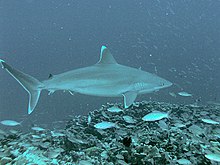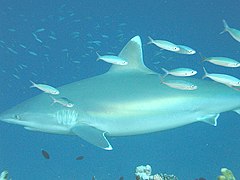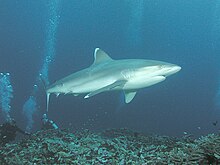Silvertip shark
This slow-reproducing species is taken by commercial fisheries for its meat, fins, skin, cartilage, and jaws and teeth, which has apparently led to local population declines or extirpations.
The silvertip shark was originally described as Carcharias albimarginatus by German naturalist Eduard Rüppell, in the 1837 Fische des Rothen Meeres (Fishes of the Red Sea).
[4] In 1960, a 103 cm (3.38 ft)-long immature male caught off Ras Muhammad in the Red Sea was designated as the type specimen.
In the western Indian Ocean, this species occurs from the Red Sea to South Africa, including Madagascar, the Seychelles, the Aldabra Group, Mauritius and the Chagos Archipelago.
In the eastern Pacific, it occurs from southern Baja California to Colombia, including the Cocos, Galapagos, and Revillagigedo Islands.
[2] Silvertip sharks are found over continental and insular shelves at a depth of 30–800 m (98–2,625 ft), occupying all levels of the water column.
[2][7] Juveniles frequent coastal shallows or lagoons, while adults occur in deeper water, with little overlap between the two age groups.
[3][8] The silvertip shark is a robust and streamlined species with a moderately long, broad snout and large, round eyes.
The pectoral fins are proportionately longer than in most requiem sharks and falcate (sickle-like) in shape, with pointed tips.
[14][15] The diet of the silvertip shark consists primarily of bony fishes, such as grouper, mackerel, tuna, escolars, lanternfish, flyingfish, wrasses, and soles.
[13] The differently shaped dentition in their upper and lower jaws allows them to tackle large prey, gripping and sawing off chunks of flesh with violent twists and turns.
[1] The growth rate is highly variable in the wild: Kato and Hernandez (1967) reported juvenile silvertip sharks grow an average of 3.8 cm (1.5 in), or 5.3% of their body length, per year, with some individuals growing as much as 20.8 cm (8.2 in), 30.1% of their body length) per year and others showing negative "growth".
[16] In one experiment involving bait, a large silvertip shark tore the leg off a dummy dressed in SCUBA gear, demonstrating that this species is capable of inflicting lethal injuries.
[20] The silvertip shark is caught by commercial and artisan fisheries across its range using longlines, gillnets, and trawls, both intentionally and as bycatch.
It is believed to have been extirpated by Indonesian artisan fishers at Scott Reef off northern Australia, and is likely becoming rare in many other parts of its range.


